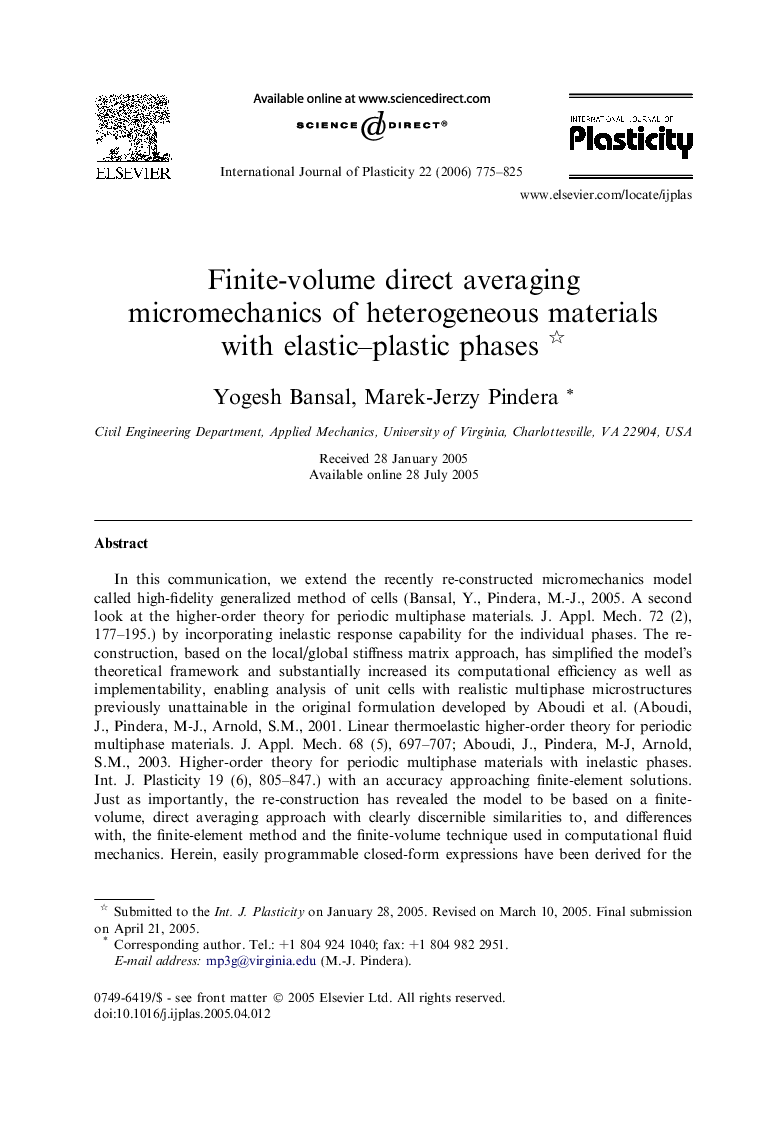| کد مقاله | کد نشریه | سال انتشار | مقاله انگلیسی | نسخه تمام متن |
|---|---|---|---|---|
| 786404 | 1465710 | 2006 | 51 صفحه PDF | دانلود رایگان |

In this communication, we extend the recently re-constructed micromechanics model called high-fidelity generalized method of cells (Bansal, Y., Pindera, M.-J., 2005. A second look at the higher-order theory for periodic multiphase materials. J. Appl. Mech. 72 (2), 177–195.) by incorporating inelastic response capability for the individual phases. The re-construction, based on the local/global stiffness matrix approach, has simplified the model’s theoretical framework and substantially increased its computational efficiency as well as implementability, enabling analysis of unit cells with realistic multiphase microstructures previously unattainable in the original formulation developed by Aboudi et al. (Aboudi, J., Pindera, M-J., Arnold, S.M., 2001. Linear thermoelastic higher-order theory for periodic multiphase materials. J. Appl. Mech. 68 (5), 697–707; Aboudi, J., Pindera, M-J, Arnold, S.M., 2003. Higher-order theory for periodic multiphase materials with inelastic phases. Int. J. Plasticity 19 (6), 805–847.) with an accuracy approaching finite-element solutions. Just as importantly, the re-construction has revealed the model to be based on a finite-volume, direct averaging approach with clearly discernible similarities to, and differences with, the finite-element method and the finite-volume technique used in computational fluid mechanics. Herein, easily programmable closed-form expressions have been derived for the thermo-inelastic contributions to the local stiffness matrix equations that facilitate incorporation of different inelastic constitutive theories for the phase response. The re-constructed model is then employed to investigate orientational and architectural effects in unidirectional metal matrix composites characterized by multi-inclusion unit cells. Classical incremental plasticity theory with isotropic hardening is employed for the matrix response for consistency and comparison with previously reported results by Aboudi et al. (2003). Unit cells representative of a square array of fibers rotated by an angle about the fiber axis, which lack planes of material symmetry in the rotated coordinate system in which the micromechanical analysis is performed, belong in the first category. New results are presented for such rotated unidirectional porous composites which suggest guidelines for optimizing stiffness and ductility of this class of light-weight materials relative to dominant loading directions. Strengthening effects due to fiber clustering, which require highly discretized multi-inclusion unit cells, fall in the second category. It is demonstrated that the previously documented results for particulate composites, explained by the clustering-induced alteration of stress invariants which govern plastic strain evolution, are recovered for unidirectional composites as well.
Journal: International Journal of Plasticity - Volume 22, Issue 5, May 2006, Pages 775–825